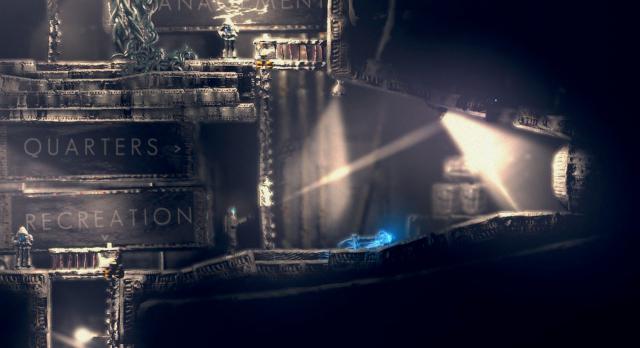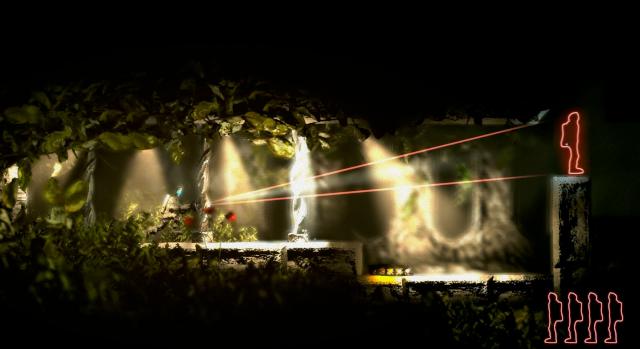
It’s almost impossible to talk about The Swapper without sounding like a pretentious cock who claims to have been given a secret inside understanding of the soul, the role of the human body in an individual’s personality and the possibility of intelligence beyond our understanding, tucked away in space rocks. Luckily, I’ve already mentioned all that and we’re still in paragraph one, so let me explain just why The Swapper should be on your PS4, PS3 or Vita now it’s available on the PSN stores everywhere.
In the opening moments The Swapper would appear to be just a puzzle game, one whereby you use a funky gun to create clones of yourself and swap between them whenever you want. Using this technique you can reach unreachable areas, stand on switches to open doors and reach orbs that are required to access various terminals. But as you soon realise there’s far more to it than a few simple point and clone problems, and as the difficulty increases, so do the questions asked throughout the game.

The first issue you face is how your clones behave – they mimic everything you do. You walk left, they walk left. You jump, they jump. If fact if you’re stood facing a wall and keep trying to walk that way, all of your clones (of which you can have up to four at once) will carry on walking until they hit a wall of plummet to their death. Clone death isn’t a problem as such, as long as it’s not the clone you’re in control of who dies, they just get wiped out and made available again as new clones. Controlled death is actually a requirement in later levels, but I’ll come to that in a while.
So you can’t just ping off a clone to stand on a switch and hope it stays there while you happily wander through the freshly opened door. Bummer. That’s not all though, as you’ll soon start to see various spotlights casting coloured lighting in certain areas. These red, blue and purple lights either block your line of sight required to swap to another clone, prevent your clone gun from getting through the light to even create a new clone, or combine the two at once. Often there will be a switch to turn the lights off, but getting a clone into position to do so is never an easy task.
What this does is take what could’ve been a decent puzzler, and turn it into something quite brilliant. There’s no punishment for failure – you just get taken back to the entrance to your current room – so experimentation is encouraged. Figuring out some of the trickier rooms can take a long time, but when you start to formulate a solution and piece it together little by little there’s an immense satisfaction when it finally works. You’ll soon start to realise some extra fun ways to use your clone gun, and the idea of creating a clone and switching to it before it’s even finished making itself to reach tricky places (even some secret hidden areas) soon becomes second nature, letting you zip round the levels as super speed.
Between all of the lighting complications and the mirrored nature of clone movements (and the later introduction of inverting gravity) puzzles can, as already said, get very demanding. It’s easy to see the idea of four clones and think you’ll have to plan four or five moves ahead, like a finely crafted game of chess. But sometimes that’s not enough; you’ll need to use a clone for something, then kill it off by intentionally sending it off a high ledge or merging it with your “live” character to make more available. Suddenly you’re thinking six, seven, eight moves ahead of what you’re currently doing, but it only very occasionally becomes too much. For 99% of the time your own logical steps will get you to the solution, leaving you to enjoy the bewilderingly beautiful atmosphere in the deserted spaceship you’re finding your way round.

Between the flawless music and echoing, haunting sounds of emptiness you’ll get plenty of chance to appreciate the visuals which, while often simple, fit the bill to a tee. Everything looks the part whether you’re on a Vita or PS4 (and with this being a 3-way cross buy with cloud saves, you can do just that) and there’s never an issue of having to strain to see what you need to be doing. Text is clear and easy to read, which is just as well considering what its function is.
This is where things get a bit unusual. Whether you’re getting echoes of thoughts by walking past lumps of rock, or discussing things with the game’s other speaking role (which shows up later, so I won’t ruin it) there’s an undeniable depth to the storyline that develops as you progress through the game. Thoughts on what the soul is, whether it’s linked to a single body or not, whether a single thought shows you have a soul, there’s a lot to be thinking about and these insights shouldn’t be dismissed by dashing past them without a second thought. It never reaches a point where you think the developers were swiftly disappearing up their own backsides, but it’s a surprising (and very welcome) plot point for what could’ve been a fairly simple and basic puzzle game.
So apart from those little moments when you get annoyed and feel like giving up ( and a couple of the later rooms will get you close) The Swapper is one of the finest games of its type that you’ll find at the moment. Cross-buy and cross-save are fantastic features that only improve the accessibility of your purchase, and the game itself has very little to fault. If you haven’t bought it yet, give it some very serious thought, because The Swapper is a very very good game.
Reviewed on PS4/PS3/Vita


Leave a Reply